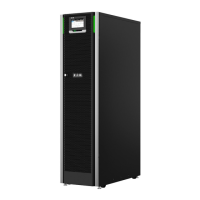Before you install the UPS system, read and understand how these instructions apply to
the system that you are going to install. Use the procedures and illustrations provided to
create a logical plan for installing the system.
2.2.2 Site preparations
For the UPS system to operate at peak efficiency, the installation site must meet the
environmental parameters outlined in the Eaton 93PS UPS 8-40 kW User’s and Installation
Guide.
2.2.2.1 Environmental and installation considerations
The installation environment must meet the UPS weight and size requirements provided in
Tables 1 and 2.
The dimensions of the UPS cabinet are shown in illustration 2. Note that the depth
dimension (750 mm) includes cable glands.
Table 1. UPS cabinet weights with cardboard packaging
8-20 kW
C-model 8-20 kW
30-40 kW
Shipping weight
293 kg
The UPS cabinets use forced air cooling to regulate internal component temperature. By
default, air inlets are in the front of the cabinet and outlets are in the back, see
illustration 3. Allow clearance in front of and behind each cabinet for proper air circulation.
Make sure that the cooling air that enters the UPS does not exceed +40 °C. For ventilation
requirements, refer to the Eaton 93PS UPS 8-40 kW User’s and Installation Guide.
Table 2. UPS cabinet minimum clearances
8-20 kW 30-40 kW
From the top of the cabinet
500 mm 500 mm
From the front of the cabinet
500 mm 650 mm
From the back of the cabinet
150 mm 250 mm
From the side of the cabinet
0 mm 0 mm
The recommended ambient operating temperature and humidity for the UPS system is
shown in illustrations 4.1 and 4.2. An ambient temperature from +20 °C to +25 °C is
recommended to achieve a long life of VRLA batteries.

